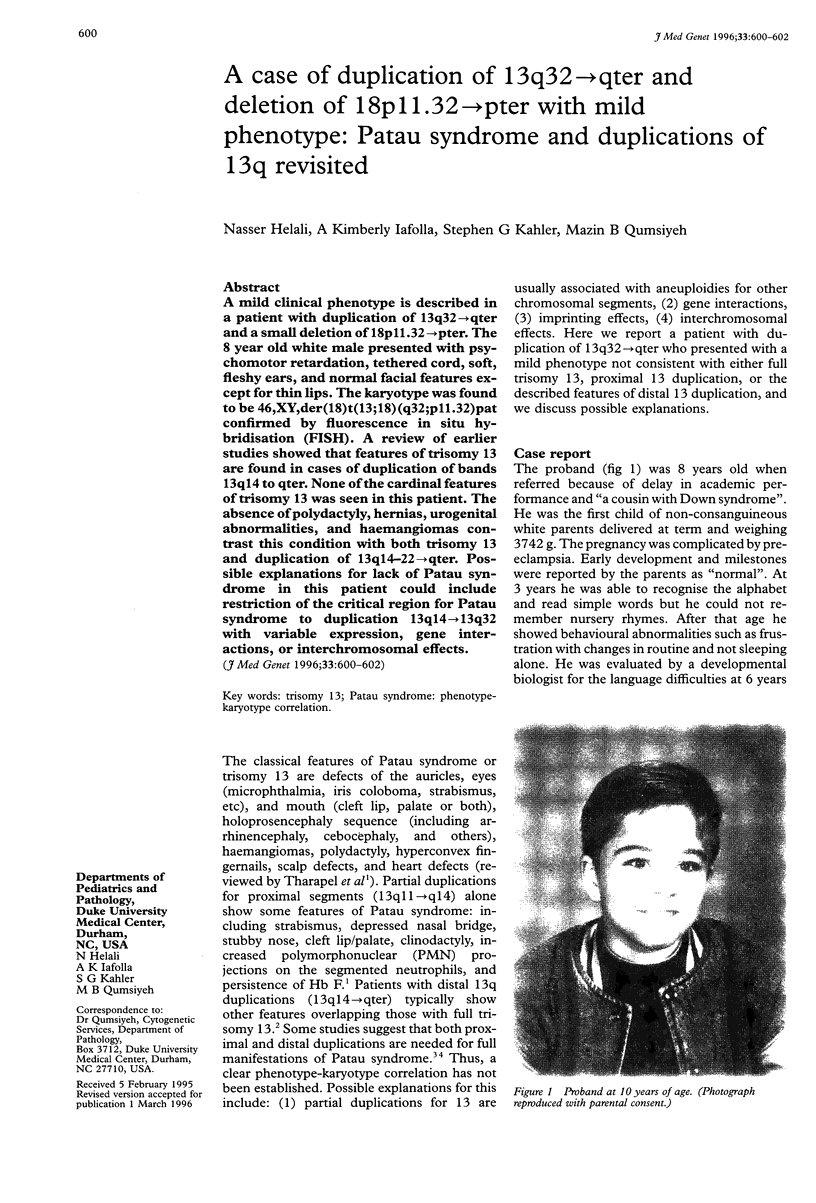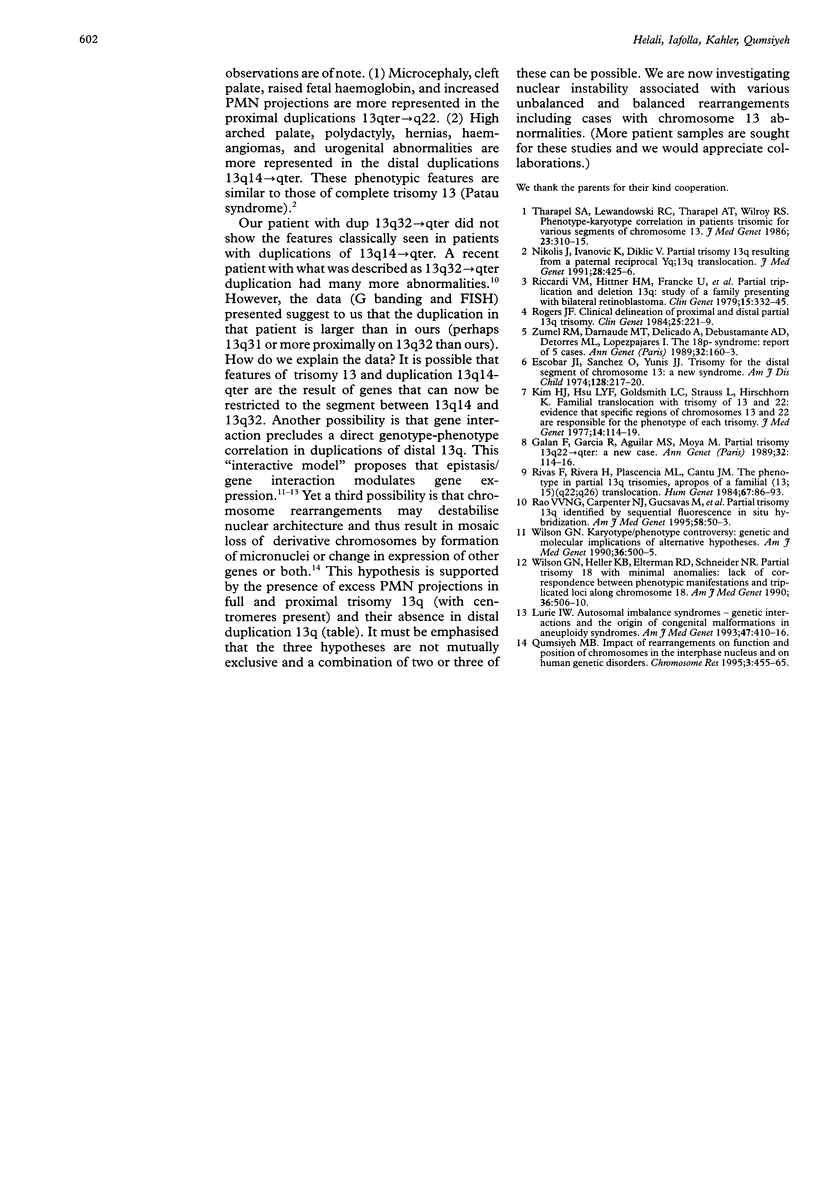Abstract
A mild clinical phenotype is described in a patient with duplication of 13q32-->qter and a small deletion of 18p11.32-->pter. The 8 year old white male presented with psychomotor retardation, tethered cord, soft, fleshy ears, and normal facial features except for thin lips. The karyotype was found to be 46, XY, der(18)t(13;18) (q32;p11.32) pat confirmed by fluorescence in situ hybridisation (FISH). A review of earlier studies showed that features of trisomy 13 are found in cases of duplication of bands 13q14 to qter. None of the cardinal features of trisomy 13 was seen in this patient. The absence of polydactyly, hernias, urogenital abnormalities, and haemangiomas contrast this condition with both trisomy 13 and duplication of 13q14-22-->qter. Possible explanations for lack of Patau syndrome in this patient could include restriction of the critical region for Patau syndrome to duplication 13q14-->13q32 with variable expression, gene interactions, or interchromosomal effects.
Full text
PDF


Images in this article
Selected References
These references are in PubMed. This may not be the complete list of references from this article.
- Escobar J. I., Sanchez O., Yunis J. J. Trisomy for the distal segment of chromosome 13: a new syndrome. Am J Dis Child. 1974 Aug;128(2):217–220. doi: 10.1001/archpedi.1974.02110270091019. [DOI] [PubMed] [Google Scholar]
- Galán F., García R., Aguilar M. S., Moya M. Partial trisomy 13q22----qter. A new case. Ann Genet. 1989;32(2):114–116. [PubMed] [Google Scholar]
- Kim H. J., Hsu L. Y., Goldsmith L. C., Strauss L., Hirschhorn K. Familial translocation with partial trisomy of 13 and 22: evidence that specific regions of chromosomes 13 and 22 are responsible for the phenotype of each trisomy. J Med Genet. 1977 Apr;14(2):114–119. doi: 10.1136/jmg.14.2.114. [DOI] [PMC free article] [PubMed] [Google Scholar]
- Lurie I. W. Autosomal imbalance syndromes: genetic interactions and the origin of congenital malformations in aneuploidy syndromes. Am J Med Genet. 1993 Sep 1;47(3):410–416. doi: 10.1002/ajmg.1320470323. [DOI] [PubMed] [Google Scholar]
- Nikolis J., Ivanović K., Diklić V. Partial trisomy 13q resulting from a paternal reciprocal Yq;13q translocation. J Med Genet. 1991 Jun;28(6):425–426. doi: 10.1136/jmg.28.6.425. [DOI] [PMC free article] [PubMed] [Google Scholar]
- Qumsiyeh M. B. Impact of rearrangements on function and position of chromosomes in the interphase nucleus and on human genetic disorders. Chromosome Res. 1995 Dec;3(8):455–465. doi: 10.1007/BF00713959. [DOI] [PubMed] [Google Scholar]
- Riccardi V. M., Hittner H. M., Francke U., Pippin S., Holmquist G. P., Kretzer F. L., Ferrell R. Partial triplication and deletion of 13q: study of a family presenting with bilateral retinoblastomas. Clin Genet. 1979 Apr;15(4):332–345. doi: 10.1111/j.1399-0004.1979.tb01743.x. [DOI] [PubMed] [Google Scholar]
- Rivas F., Rivera H., Plascencia M. L., Ibarra B., Cantú J. M. The phenotype in partial 13q trisomies, apropos of a familial (13;15)(q22;q26) translocation. Hum Genet. 1984;67(1):86–93. doi: 10.1007/BF00270563. [DOI] [PubMed] [Google Scholar]
- Rogers J. F. Clinical delineation of proximal and distal partial 13q trisomy. Clin Genet. 1984 Mar;25(3):221–229. doi: 10.1111/j.1399-0004.1984.tb01982.x. [DOI] [PubMed] [Google Scholar]
- Tharapel S. A., Lewandowski R. C., Tharapel A. T., Wilroy R. S., Jr Phenotype-karyotype correlation in patients trisomic for various segments of chromosome 13. J Med Genet. 1986 Aug;23(4):310–315. doi: 10.1136/jmg.23.4.310. [DOI] [PMC free article] [PubMed] [Google Scholar]
- Wilson G. N., Heller K. B., Elterman R. D., Schneider N. R. Partial trisomy 18 with minimal anomalies: lack of correspondence between phenotypic manifestations and triplicated loci along chromosome 18. Am J Med Genet. 1990 Aug;36(4):506–510. doi: 10.1002/ajmg.1320360427. [DOI] [PubMed] [Google Scholar]
- Wilson G. N. Karyotype/phenotype controversy: genetic and molecular implications of alternative hypotheses. Am J Med Genet. 1990 Aug;36(4):500–505. doi: 10.1002/ajmg.1320360426. [DOI] [PubMed] [Google Scholar]
- Zumel R. M., Darnaude M. T., Delicado A., Diaz de Bustamante A., de Torres M. L., López-Pájares I. The 18p- syndrome. Report of five cases. Ann Genet. 1989;32(3):160–163. [PubMed] [Google Scholar]




